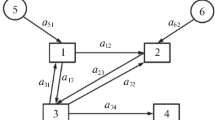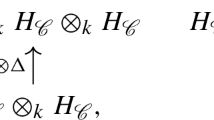Abstract
On the basis of the analysis of the functioning of complex special-purpose information systems, a general approach was proposed to their mathematical modeling and structural decomposition, based on topological constructions using the theory of the final semigroups. The connection between any transformations of a complex system in the finite space of its states and certain valid coordinatization variants is defined for the final semigroups. Various generalized indicators of evaluation of functional structure simplexes, which allowed one to obtain the characteristics of these complexes, have been determined. The proposed method of analysis allowed more objective analysis of the q-connectivity of the simplexes and the observability and controllability of the special-purpose complex information system. Definitions, theorems, and proofs are presented, which allows calculation of the sequence of composition and the integration of the subsystems of a complex system into a single whole.


Similar content being viewed by others
REFERENCES
Casti, J.L., Connectivity, Complexity and Catastrophe in Large-Scale Systems, Chichester, UK: John Wiley & Sons, 1979.
Kron, G., Diakoptics: The Piecewise Solution of Large-Scale Systems, London: MacDonald, 1963.
Kudzh, S.A and Tsvetkov, V.Ya., Trinitarian systems, Ross. Tekhnol. Zh., 2019, vol. 7, no. 6, pp. 151–167. https://doi.org/10.32362/2500-316X-2019-7-6-151-167
Tyutyunnik, V.M., Thermodynamics of irreversible processes and self-organization in information flows, Int. J. Adv. Res. IT Eng., 2019, vol. 8, no. 3, pp. 18–24.
Gromov, Yu.Yu., Minin, Yu.V., Ivanova, O.G., and Ryzhkov, A.P., Modeling of information systems based on the use of discrete and continuous distribution laws and their approximation, Pribory Sist.. Upr., Kontrol’, Diagnost., 2019, no. 3, pp. 26–33.
Gromov, Yu.Yu., Didrikh, V.E., Didrikh, I.V., and Grechushkina, A.Yu., Construction of intellectual systems o fcontrol of information processes in conditions of uncertainty, Mod. Sist. Protsessov, 2018, vol. 11, no. 1, pp. 10–14. https://doi.org/10.12737/article_5b574c7c299958.66418026
Tyutyunnik, V.M., Data analysis and model of information processes for the formation of applied information systems, Promyshl. ASU i Kontrollery, 2019, no. 4, pp. 19–29.
Gromov, Yu.Yu., Karpov, I.G., Ishchuk, I.N., Minin, Yu.V., Ivanova, O.G., and Tyutyunnik, V.M., Modelirovanie informatsionnykh sistem na osnove zakonov raspredeleniya sluchainykh velichin (Modeling Information Systems Based on Laws of Distribution of Random Values), Tyutyunnik, V.M., Ed., Moscow: Nobelistika, 2019.
Sumin, V.I. and Smolentseva, T.E., Forming a model of the interaction between information flows in systems, Vestn. Voronezh. Inst. Fed. Sluzhby Ispolneniya Nakazanii Ross., 2016, no. 2, pp. 61–64.
Sumin, V.I., Dushkin, A.V., and Smolentseva, T.E., Mathematical models to determine stable behavior of complex systems, J. Phys.: Conf. Ser., 2018, vol. 1015, p. 032136. https://doi.org/10.1088/1742-6596/1015/3/032136
Sumin, V.I. and Smolentseva, T.E., The formation of the structure of hierarchical multi-level organizational systems, Inf. Tekhnol., 2017, vol. 23, no. 6, pp. 476–480.
Gromov, Yu.Yu. and Tyutyunnik, V.M., Materials for the information theory elaboration. 1. information quantity and quality measures, J. Int. Sci. Publ.: Mater. Methods Tekhnol., 2011, vol. 5, no. 1, pp. 230–241.
Gromov, Yu.Yu. and Tyutyunnik, V.M., Materials to construction of the theory of information. 1. Measuring the amount and quality of information, Fundam. Issled., 2011, no. 8, pp. 347–355.
Gromov, Yu.Yu., Tyutyunnik, V.M., and Minin, Yu.V., Materials to the theory of information elaboration. 2. Information systems modelling, Int. J. Res. Eng., IT Soc. Sci., 2018, vol. 8, no. 6, pp. 1–14.
Gromov, Yu.Yu., Tyutyunnik, V.M., and Minin, Yu.V., Materials to the theory of information elaboration. 3. Information systems modelling, Materialy XVIII Mezhdunarod. Nauchn. Konf. Formirovanie Professionala v Usloviyakh Regiona: Novye Podkhody (Materials of the 18th Int. Sci. Conf. Formation of Professional under Conditions of Region: New Approaches), Tyutyunnik, V.M. and Zernov, V.A., Eds., Tambov: Nobelistika, 2018, pp. 87–106.
Gromov, Yu.Yu., Tyutyunnik, V.M., and Minin, Yu.V., Materials to the theory of information elaboration. 4. Tensor measurement of information for modeling an information system, in Inf. Sist. Protsessy, Tyutyunnik, V.M., Ed., Tambov: Nobelistika, 2018, vol. 17, pp. 7–28.
Timofeev, D.N. and Tyutyunnik, V.M., Information support for acceptance of group decisions in poly-structural process-oriented system of the enterprise, Pribory Sist. Upr., Kontrol’, Diagnost., 2020, no. 6, pp. 22–26. https://doi.org/10.25791/pribor.06.2020.1182
Tyutyunnik, V.M., Gromov, Yu.Yu., and Aleksandrov, E.Yu., Analytical models of parrying negative external influences on a network information system, Autom. Doc. Math. Linguist., 2020, vol. 54, no. 5, pp. 250–254. https://doi.org/10.3103/S0005105520050040
Gromov, Yu.Yu., Ivanova, O.G., Ivanovskii, M.A., Minin, Yu.V., and Tyutyunnik, V.M., Application of tensor analysis to information systems building, Nauka, Tekhnol., Obshch. i Mezhdunarod. Nobelevskoe Dvizhenie (Science, Technology, Society and International Nobel Movement), Tyutyunnik, V.M., Ed., Tambov: Mezhdunarod. Inf. Nobelevskii Tsentr, 2017, pp. 418–424.
Sumin, V.I. and Smolentseva, T.E., Technique of grouping basic information for information processes of complex systems, Nauchn. Vedom. Belgorod. Gos. Univ. Ser.: Ekon., Inf., 2015, no. 13, pp. 104–108.
Mesarovich, M. and Takakhara, Ya., Obshchaya teoriya sistem: matematicheskie osnovy (General Systems Theory: Mathematical Foundations), Moscow: Mir, 1978.
Kuz’min, V.B., Postroenie gruppovykh reshenii v prostranstve chetkikh i nechetkikh binarnykh otnoshenii (Construction of Group Solutions in the Space of Clear and Fuzzy Binary Relationships), Moscow: Sovetskoe radio, 1982.
Kuz’min, I.V., Otsenka effektivnosti i optimizatsiya avtomaticheskikh sistem kontrolya i upravleniya (Estimating Efficiency and Optimization of Automated Systems of Monitoring and Control), Moscow: Sovetskoe Radio, 1971.
Author information
Authors and Affiliations
Corresponding authors
Additional information
Translated by S. Avodkova
About this article
Cite this article
Sumin, V.I., Smolentseva, T.E., Gromov, Y.Y. et al. Analysis of the Functioning and Structural Decomposing of Special-Purpose Information Systems. Autom. Doc. Math. Linguist. 55, 169–177 (2021). https://doi.org/10.3103/S0005105521040087
Received:
Published:
Issue Date:
DOI: https://doi.org/10.3103/S0005105521040087
Keywords:
- complex system
- special-purpose information system
- algebraic and topological approaches
- finite-dimensional space of states
- theory of the final semigroups
- simplicial complex
- measure of nonconformity of the simplex
- q-analysis
- Kalman criterion
- Gramm matrix
- linear dynamic discrete system
- control matrix
- control vector
- system’s interference vector
- incidence of the graph
- Euclidean space coordinates
- triggers
- Crohn–Rhodes theorem




